Abstracts - Chirurgie Kongress
Abstracts - Chirurgie Kongress
Abstracts - Chirurgie Kongress
You also want an ePaper? Increase the reach of your titles
YUMPU automatically turns print PDFs into web optimized ePapers that Google loves.
phalic trunk was performed and in one patient, total arch rerouting was required to gain sufficient<br />
proximal landing zone. Indications for stent-graft placement were aneurysms (n=9) and penetrating<br />
ulcers (n=6).CSF drainage was initiated only in case of neurologic symptoms. In all patients mean<br />
blood pressure was kept above 80 mmHg for 96 hours after stent-graft placement.<br />
Results: Arch rerouting and stent-graft placement were performed successfully in all patients. Mean<br />
number of stent-grafts used was 2.2. One early type III endoleak was observed and treated by overstenting.<br />
No late endoleaks occured. Symptoms of spinal cord malperfusion were observed in 2 patients<br />
(13.3%). In one patient paraplegia was seen, resolving after CSF drainage (6.7%). Another patient<br />
developed signs of chronic spinal cord ischemia (6.7%). This patient had undergone replacement of<br />
the abdominal aorta 6 years prior to stent-graft placement. CSF drainage did not improve symptoms<br />
in this patient. In all other patients no signs of spinal cord malperfusion could be detected. One patient<br />
died 6 months after stent-graft placement from myocardial infarction.<br />
Conclusion: This study outlines the safety and practicability of the complete coverage of the descending<br />
aorta from trunk to trunk. The low number of signs of spinal cord malperfusion could be explained<br />
by aggressive rerouting procedures resulting in sufficient collateral flow from the left subclavian artery<br />
and by an intended elevation of postoperative blood pressure. CSF drainage is not required on a regular<br />
basis in these patients.<br />
10.6<br />
Konventionelle und konfokale lichtmikroskopische Befunde der pathologisch veränderten Aorta<br />
ascendens<br />
J. Janzen, L. Englberger, I. Schwegler, R. Von Allmen, M. Widmer, J. Schmidli (Bern)<br />
Objective: Lichtmikroskopische Untersuchungen sind bestens geeignet, um neue Erkenntnisse in<br />
der Aortenpathologie zu gewinnen. Dabei zeichnet die fokusorientierte konfokale Lichtmikroskopie<br />
im Gegensatz zur konventionellen Histopathologie optische Schnitte auf, die digital zu einem 3D-Bild<br />
verarbeitet werden.<br />
Methods: Intraoperativ wurden Proben aus der Aorta ascendens entnommen. Die Präparate wurden<br />
zugeschnitten und in Paraffinblöcke eingebettet. Danach erfolgten die Schnittherstellungen am<br />
Mikrotom und die Anfärbungen, inklusive Immunhistochemie. Mit Hilfe der konventionellen und der<br />
konfokalen Lichtmikroskopie (Lasermikroskopie) wurden nun die angefertigten Schnittpräparate näher<br />
untersucht.<br />
Results: Im Zeitraum von 8 Monaten wurden 30 Patienten operiert: Klinisch waren 19 Aneurysmata<br />
und 11 Dissektionen bekannt; aortenpathologisch dominierten Mediaveränderungen in 24 Fällen; 3<br />
Fälle zeigten eine schwere Atherosklerose und weitere 3 Fälle präsentierten Adventitiaveränderungen.<br />
Zudem hatten alle Patienten pathologi-sche Vasa vasorum. Die selektiv eingesetzte Lasermikroskopie<br />
zeigte neue Aspekte der Mediakomposition auf, insbesondere in der 3D-Anordnung der elastischen<br />
Fasern.<br />
Conclusion: Die konfokale Lichtmikroskopie (Lasermikroskopie) ist eine Bereicherung in der diagnostischen<br />
Palette der Aortenerkrankungen.<br />
10.7<br />
Subakutes Leriche-Syndrom als Erstmanifestation eines Antiphospholipid-Syndrom<br />
R. Marti, R. Bühlmann, L. Gürke, P. Stierli (Aarau/Basel)<br />
Objective: Fallbericht.<br />
Methods: Ein 35-jähriger Patient erlitt Wochen vor der Hospitalisation ein Trauma der Grosszehe links<br />
mit Entwicklung eines lokalen Infekt. Trotz Debridement mit, schlussendlich Nagelextraktion, entwickelte<br />
sich eine Wundheilungsstörung mit Nekrose mit lokal starken Schmerzen. In den vorangehenden<br />
Wochen bemerkte der Patient eine zunehmende Claudicatio bis hin zu Ruheschmerzen. Aus der<br />
Vorgeschichte sind drei Ereignisse von Beinvenenthrombosen bekannt, einmalig erlitt der Patient eine<br />
Lungenembolie. Eine Gerinnungsabklärung wurde nie durchgeführt.<br />
Bei Eintritt präsentierte sich der Patient mit fehlenden peripheren Pulsen. Die ABI-Werte betrugen rechts<br />
0.63, links 0.49. Im Duplex vollständiger Verschluss der infrarenalen Aorta unterhalb der AMI und der<br />
AIC beidseits. Als Hinweis auf eine Gerinnungsstörung fiel bei Eintritt eine Erhöhung der aPTT auf 47<br />
auf, des weiteren bestand eine Thrombopenie von 122. Der Patient wurde therapeutisch heparinisiert.<br />
Am geplanten Operationstag entwickelte der Patient ein Ischämiesyndrom des rechten Beines bei embolischem<br />
Verschluss der Pop II. Es erfolgte die Implantation einer aorto-bifemoralen Y-Prothese mit<br />
Integration der AMI sowie die Embolektomie der Pop. II rechts.<br />
Results: In der Gerinnungsabklärung konnte schliesslich eine Erhöhung der Antipholspholipide, positive<br />
Lupus Anticoagulans-Teste sowie erhöhte Anti-B2 Glycoprotein-1-AK diagnostiziert werden, sodass<br />
die Diagnose eines Antiphospholipidsyndrom gestellt werden konnte.<br />
Conclusion: In der Literatur werden nur Einzelfälle von einem Aortenverschluss bei APS beschrieben.<br />
Trotzdem muss bei jungen Patienten mit einem Leriche-Syndrom differentialdiagnostisch eine Gerinnungsstörung<br />
als Ursache in Betracht gezogen werden. Das APS ist in hohem Masse mit arteriellen<br />
und venösen Thrombosen vergesellschaftet. 10% der arteriellen oder venösen Gefässverschlüsse<br />
sind bedingt durch ein APS, 30% der Patienten mit einem APS sind ohne Behandlung von einem<br />
thrombotischen Geschehen betroffen. Bei venösen Thrombosen in ungewöhnlicher Lokalisation, rezidivierenden<br />
Thrombosen ohne erkennbare Ursache, bei jungen Patienten mit Ischämien ohne Atherosklerose<br />
und bei Frauen mit rezidivierenden Aborten muss immer ein APS ausgeschlossen werden.<br />
Therapieziel ist die Vermeidung von weiteren thrombotischen Ereignissen. Empfohlen wird eine OAK<br />
mit einem Ziel INR von 2.5 bis 3.5.<br />
18 swiss knife 2009; special edition<br />
10.8<br />
Long - term results employing balloon-expandable LifePath endografts in AAA: wire form fractures<br />
challenge the entire concept<br />
S. Ockert 1 , H. on Tengg-Kobligk 2 , T. Kippenhan 2 , D. Böckler 2 , H.-H. Eckstein 1 ,<br />
H. Schumacher 2 ( 1 München/DE, 2 Heidelberg/DE)<br />
Objective: In the 8-year period from 1997 and 2004, the trimodular LifePath AAA Endograft device<br />
was the only commercially available balloon-expandable stentgraft for use in endovascular aortic repair<br />
(EVAR) of infrarenal aortic aneurysms. The published initial short- and midterm results were quite<br />
promising especially for patients with complex neck morphology and calcified tortuous iliac arteries.<br />
The purpose of this large retrospective single-center study is to analyze the long-term results after Life-<br />
Path endoprosthesis implantation primary focussing on the wire-form fracture issue and consecutive<br />
endoleak rate.<br />
Methods: Between 1999 and 2004 all consecutive patients being employed LifePath AAA devices in<br />
our institution were included in the study. Perioperatively all patients had CTA imaging and image postprocessing.<br />
The follow up using CTA imaging were specifically addressing material fatigue (wire-form<br />
fractures) resulting in migrations and type I endoleaks.<br />
Results: During the 6 year study period including one year withdrawal and redesigning of the device,<br />
a total of 51 patients were treated employing LifePath AAA endografts. The 30-day mortality was 0%,<br />
the perioperative 30-day morbidity was 9.8%. The primary endoleak rate was 20.56% (type I: 2%; type<br />
II: 19.6%). Over the follow-up period of mean 40.7 months, 12 patients died and 6 patients were lost in<br />
follow-up. 32 patients could be analyzed with subsequent CTA imaging. In 9 patients (28%) demonstrated<br />
a proximal type I endoleak, 7 (22%) had a type II and three patients a type III endoleak (9%).<br />
In 9 patients (28.1%) wire form fractures could be detected at image postprocessing. Four patients<br />
required a secondary conversion due to endoleak and aneurysm growth (2 type I endoleaks and 2<br />
type III endoleaks).<br />
Conclusion: The results of this retrospective study show that the wireform fracture is the major achille`s<br />
verse in the LifePath balloon-expandable endograft device resulting in a significant endoleak rate. As<br />
a result, the entire concept of using a balloon-expandable endograft system failed in the long-term.<br />
We must give a word of caution in those patients with a LifePath device in-situ. They must carefully<br />
followed-up due to material fatigue and should be considered for secondary conversion.<br />
10.9<br />
Markers of renal injury following elective abdominal aortic surgery<br />
J. Schmidli 1 , F. Dick 2 , B. Gahl 1 , T. Carrel 1 , M. K. Widmer 1 ( 1 Bern, 2 London/GB)<br />
Objective: Acute renal failure is a severe complication in the AAA patient leading to increased mortality<br />
and hospital costs. We have conducted a prospective non-randomised trial to evaluate different markers<br />
of renal injury following elective abdominal aortic surgery.<br />
Methods: 100 consecutive patients scheduled for elective repair of AAA were included in the study. 67<br />
patients underwent open aneurysm repair with infrarenal clamping (OARi), 9 with suprarenal clamping<br />
(OARs) and 24 patients had endovascular aneurysm repair (EVAR). Mean age was 71.4 ± 8.1<br />
years. Max. aneurysm diameter was 6.2 ± 1.4 cm. Mean length of hospital stay was 11.6 ± 5.7 days.<br />
Mean preoperative serum creatinine was 105 ± 23 mmol/l and not different between the groups. The<br />
following markers of renal injury were determined before surgery and day 1, 2 and 5 after surgery:<br />
serum creatinine (CREA), serum urea (UREA), glomerular filtration rate (GFR), fractionated Na urine<br />
excretion (FNA), transtubular K gradient (TTK) and urine albumine (ALB).<br />
Results: EVAR patients were significantly (sig.) older, had less blood loss and a shorter hospital stay<br />
than OAR patients. There was no in-hospital mortality and no patient required hemodialysis. Markers of<br />
renal injury: CREA and FNA did sig. increase in OARs patients on day two and turned back to basic level<br />
on day 5. After OARi and EVAR they remained stable. ALB was sig. higher in EVAR patients on day 2<br />
compared to OARi patients. TTK gradient was not different between the groups. UREA increased sig. on<br />
day two in OARs versus EVAR but not versus OARi. GFR did sig. decrease in OARs patients immediately<br />
after the procedure until day two and reached basic level on day 5.<br />
Conclusion: Kidney injury occurs in many patients undergoing infrarenal aortic surgery but does not<br />
necessarily reach clinical significance. Patients with supraaortic clamping developed temporary renal<br />
dysfunction. There was no difference between OARi and EVAR patients with respect to the markers<br />
except for albumine. Most markers of renal dysfunction normalize within 5 days after the procedure.<br />
Thoracic Surgery 12<br />
12.1<br />
Die minimal-invasive Trichterbrustkorrektur analog Nuss-Erfahrungen zu Kurz- und Langzeitergebnissen<br />
an 62 jugendlichen und erwachsenen Patienten<br />
N. W. Simbrey, B. Hoksch, R. A. Schmid (Bern)<br />
Objective: Die minimal-invasive Trichterbrustkorrektur mittels Pectus Bar ist eine seit 1987 bei Kindern<br />
und in den Folgejahren auch bei Erwachsenen mit Erfolg angewandte Operationstechnik. Die Indikation<br />
zur Operation wird bei kardio-respiratorischen sowie zunehmend bei psychischen Problemen<br />
gestellt. Die vorliegende prospektive Anwendungsbeobachtung zeigt die Ergebnisse dieser Technik bei<br />
Jugendlichen und Erwachsenen im Kurz- und Langzeitverlauf.<br />
Methods: Im Zeitraum 09/2002 bis 08/2008 wurden 62 Patienten mit einer Trichterbrust primär mit<br />
der Technik nach Nuss operiert, wobei der jüngste Patient 15 Jahre, der älteste Patient 56 Jahre alt<br />
war. Alle Patienten wurden präoperativ einer umfangreichen kardio-pulmonalen und psychologischen



